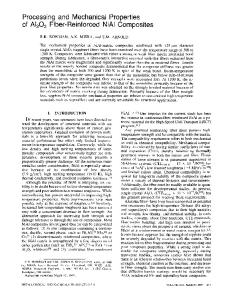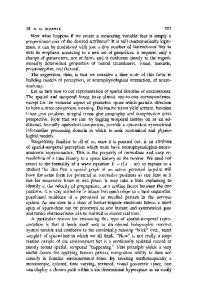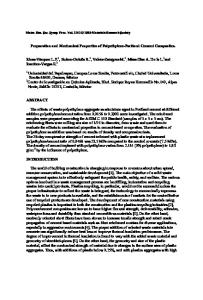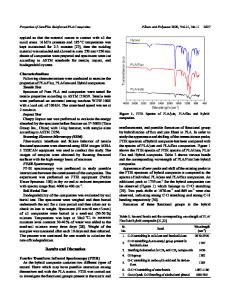Processing and Mechanical Properties of SiC-Metal Interpenetrating Composites
- PDF / 1,677,565 Bytes
- 6 Pages / 414.72 x 648 pts Page_size
- 83 Downloads / 356 Views
ABSTRACT In this paper we demonstrate a liquid exchange process to introduce a ductile metal reinforcement phase in the amount of 10-30 vol. % into reaction-bonded silicon carbides (RBSCs). Immersion of RBSC in pure Al or Al-Si melts enables diffusional replacement of secondary phase silicon with metal. The Al and Al-Si exchanged composites show improvement in fracture toughness (single edge precracked beam technique) to 6-7 MPa.m12 as compared to 3-4 MPa-m1/2 in otherwise similar siliconized silicon carbide. Increased fracture strength (four point flexure) was also observed after the liquid exchange process. INTRODUCTION Silicon carbide-metal composites containing a high volume fraction of SiC (as opposed to metal matrix composites) are of potential interest for structural applications [1,2] and as packaging for electronic components [3]. The presence of a metallic secondary phase is expected to improve strength and fracture toughness. SiC-Al composites have been of particular interest for electronic packaging due to their high thermal conductivity and potential for good thermal expansion match with Si and GaAs [3]. A conventional method of processing such composites involves the pressure-infiltration of SiC powder with a non-wetting metal. Hozer and Chiang [2,4] have recently demonstrated that SiC-AlSi composites containing a high volume fraction of SiC can be fabricated by reactiveinfiltration of porous carbon preforms using Al-Si melts. In the course of studying this synthesis route, it was discovered that the diffusional liquid exchange occurs readily between a source melt and the secondary liquid phase within a reacted SiC skeleton [2,4]. Simultaneous infiltration, reaction, and diffusional exchange typically occurs during reactive-infiltration; the relative rates of these processes determine the composition of the secondary phases and any gradients in phase content. In this work we demonstrate that liquid phase diffusional exchange can be useful as a separate process for fabricating SiC-metal composites. Results in the SiC-Al-Si system are presented. Reaction-bonded silicon carbide (siliconized silicon carbide) samples are immersed in metal alloy melts, whereupon simultaneous diffusion of metal into the composite and silicon outward results in enrichment of the secondary phase in metal while the SiC phase remains largely unchanged. The resulting SiC-metal composites exhibit increased fracture toughness and flexural strength compared to the initial siliconized silicon carbides.
423
Mat. Res. Soc. Symp. Proc. Vol. 410 01996 Materials Research Society
EXPERIMENTS We used two kinds of starting materials: a fine-grained SiC-Si composite reactioninfiltrated at MIT [1,2] and a commercial, coarse-grained CRYSTARTM composite from the Norton Company, Worcester, MA. The cylindrical samples (70 mm length, 10 mm diameter) fabricated at MIT, identified by the prefixes 2, 3, and 4, were characterized by SiC contents of 63 vol.%, 78 vol.%, and 86 vol.%, respectively (Table I). The rectangular CRYSTAR TM samples (70 x 50 x
Data Loading...











